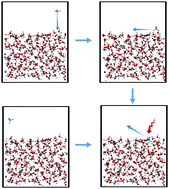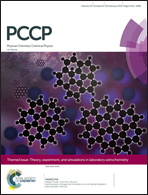Molecular dynamics simulations of energy dissipation and non-thermal diffusion on amorphous solid water†
Abstract
Molecules in space are synthesized via a large variety of gas-phase reactions, and reactions on dust-grain surfaces, where the surface acts as a catalyst. Especially, saturated, hydrogen-rich molecules are formed through surface chemistry where the interstellar grains act as a meeting place and absorbing energy. Here we present the results of thousands of molecular dynamics simulations to quantify the outcome of an energy dissipation process. Admolecules on top of an amorphous solid water surface have been given translational energy between 0.5 and 5 eV. Three different surface species are considered, CO2, H2O and CH4, spanning a range in binding energies, number of internal degrees of freedom and molecular weight. The results are compared against a previous study using a crystalline water ice surface. Possible outcomes of a dissipation process are adsorption – possibly after long-range diffusion-, desorption and desorption of a surface molecule. The three admolecules were found to bind at different locations on the surface, particularly in terms of height. Water preferably binds on top of the surface, whereas methane fills the nanopores on the surface. This has direct consequences for desorption, travelled distance, and kick-out probabilities. The admolecules are found to frequently travel several tens of angstroms before stabilizing on a binding site, allowing follow-up reactions en route. We present kick-out probabilities and we have been able to quantify the desorption probability which depends on the binding energy of the species, the translational excitation, and a factor that accounts for difference in binding site height. We provide expressions that can be incorporated in astrochemical models to predict grain surface formation and return into the gas phase of these products.

- This article is part of the themed collection: Theory, experiment, and simulations in laboratory astrochemistry


 Please wait while we load your content...
Please wait while we load your content...